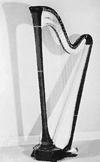- harp
-
—harplike, adj./hahrp/, n.1. a musical instrument consisting of a triangular frame formed by a soundbox, a pillar, and a curved neck, and having strings stretched between the soundbox and the neck that are plucked with the fingers.2. anything that resembles this instrument, esp. in having a row of parallel strings or wires, as various mechanical devices or kitchen implements for slicing cheese.3. a vertical metal frame shaped to bend around the bulb in a standing lamp and used to support a lamp shade.4. Slang (disparaging and offensive). a person of Irish birth or descent.5. Also called harper. any of several English coins issued for use in Ireland during the 16th and 17th centuries, bearing the figure of a harp on the reverse.6. South Midland and Southern U.S. a mouth harp; harmonica.v.i.7. to play on a harp.8. harp on or upon, to dwell on persistently or tediously in speaking or writing: He was always harping on the importance of taking vitamin supplements.[bef. 900; ME harpe, OE hearpe; c. D harp, G Harfe, ON harpa]
* * *
Plucked stringed instrument in which the resonator, or belly, is perpendicular to the plane of the strings.Harps are roughly triangular. In early harps and many folk harps, the strings are strung between the resonating "body" and the "neck." Early harps and many folk harps lack the forepillar or columnforming the third side of the trianglethat characterizes frame harps; the column permits high string tension and higher-pitched tuning. Small, primitive harps date back to at least 3000 BC in the ancient Mediterranean and Middle East. In Europe they became particularly important in Celtic societies. The large modern orchestral harp emerged in the 18th century. It has 47 strings and a range of almost seven octaves. It plays the entire chromatic (12-note) scale by means of seven pedals, each of which can alter the pitch of a note (in all octaves) by two semitones through tightening or relaxing the strings by turning a forklike projection against it; it is thus known as the double-action harp. Its massive resonator permits considerable volume of tone. See also Aeolian harp. Double-action pedal harpBy courtesy of Lyon-Healy
Double-action pedal harpBy courtesy of Lyon-Healy* * *
stringed instrument in which the resonator, or belly, is perpendicular, or nearly so, to the plane of the strings. Each string produces one note, the gradation of string length from short to long corresponding to that from high to low pitch. The resonator is usually of wood or skin. In arched, or bow-shaped, harps the neck extends from and forms a curve with the body. In angular harps (see photograph—>), body and neck form an angle. In frame harps (frame harp) (mostly confined to Europe), body and neck are set at an angle and are connected by a column, pillar, or forepillar, that braces against the tension of the strings. Harps lacking a forepillar are strung at relatively low tension, which results in a lower pitch than frame harps. The modern double-action pedal harp combines the basic structure and sound of ancient harps with a complex mechanism in order to obtain a full chromatic range.Harps were widely used in the ancient Mediterranean and Middle East, although rare in Greece and Rome; depictions survive from Egypt and Mesopotamia from about 3000 BC. Many were played in vertical position and plucked with the fingers of both hands, but Mesopotamia also had horizontal harps. Placed on the player's lap, strings toward him, they were plucked with a plectrum. Horizontal harps are pictured in India as late as AD 800 but apparently died out in the Middle East about AD 600. At this same time arched harps (arched harp) fell out of use in the Middle East but survive today in Africa, Myanmar (Burma), and a few isolated areas. Angular harps survived until the 19th century in Iran.Frame harps appeared in Europe by the 9th century; their ultimate origin is uncertain. Medieval harps were apparently wire strung, typically had outcurving forepillars, and eventually were tuned diatonically (seven notes per octave). They were particularly important in Celtic societies. In the late 14th century the earlier form was displaced on the Continent by the Gothic harp, with a slender, straighter neck; thin, shallow soundbox; and nearly straight pillar. By approximately 1500, possibly earlier, it was strung with gut strings. This European diatonic harp developed into the modern harp and survives in the folk harps of Latin America.From the 17th century the harp was progressively subject to efforts to give it the chromatic notes demanded by changing musical styles. Two approaches were used: hooks or pedal mechanisms that altered the pitch of selected strings when necessary, and harps with 12 strings per octave (chromatic harps).Hooks were first used in the Tirol in the 17th century. In 1720 the Bavarian Celestin Hochbrucker added seven pedals that controlled the hooks via levers set in the forepillar. Hochbrucker's single-action pedal harp was improved in 1750, when Georges Cousineau replaced the hooks with metal plates that gripped the strings while leaving them in plane, and in 1792, when Sébastian Érard substituted rotating disks for the metal plates.Chromatic harps were built as early as the 16th century—e.g., the double harp, with two rows of strings, and the Welsh triple harp, with three rows. They also include the chromatic harp, invented in the late 19th century by the Pleyel firm of Paris, with two crossing sets of strings (like an X), and its U.S. predecessor, in which each set of strings has a separate neck and forepillar.* * *
Universalium. 2010.
